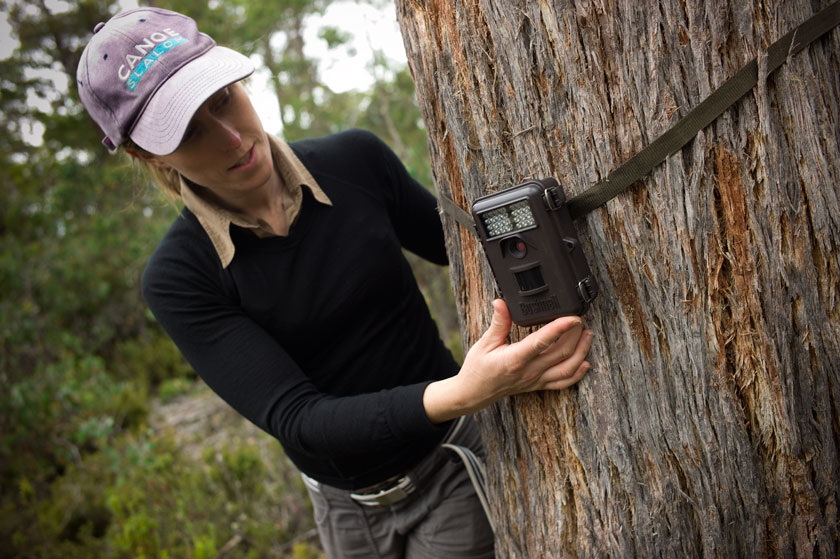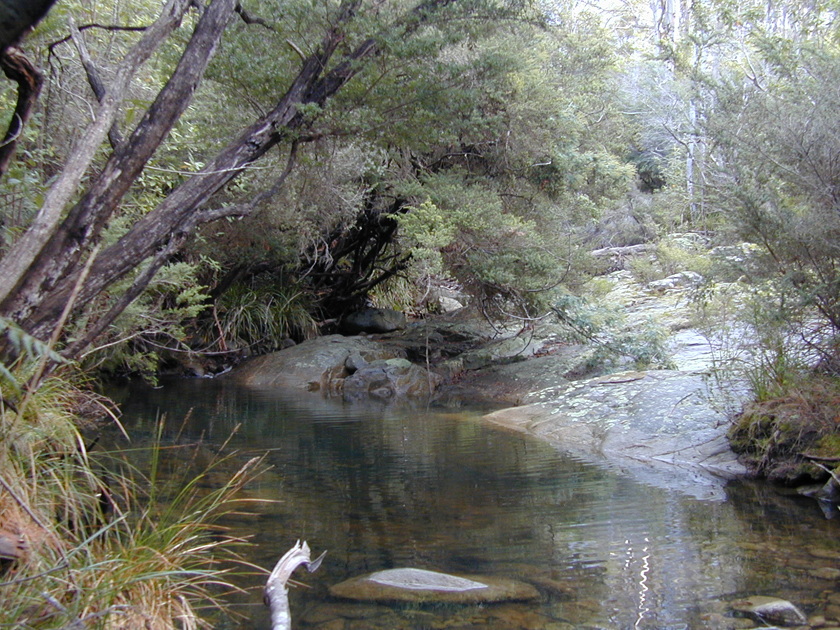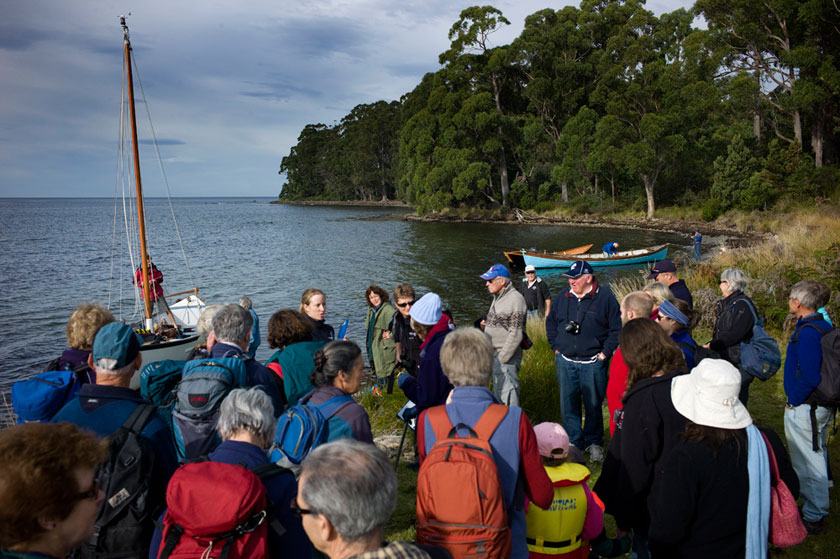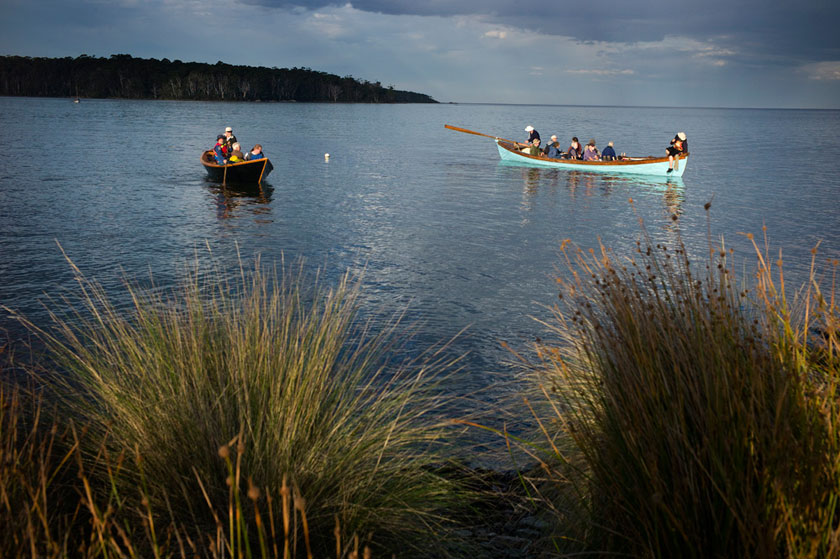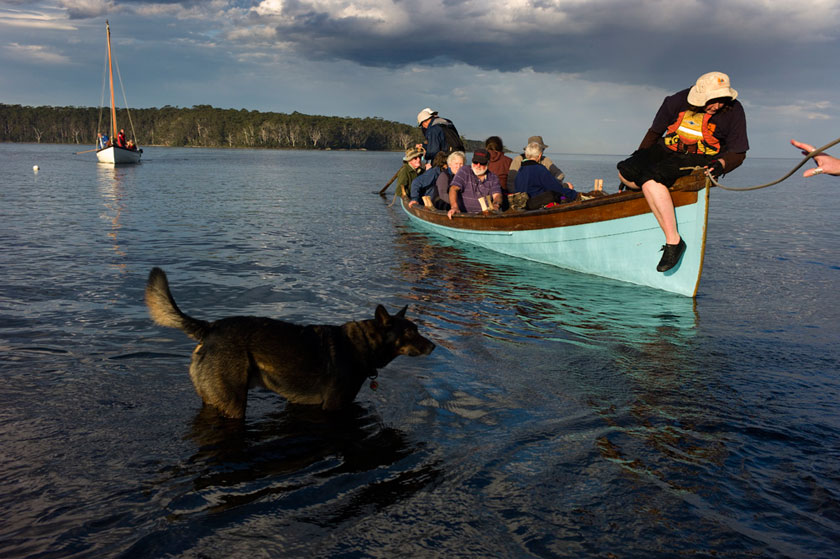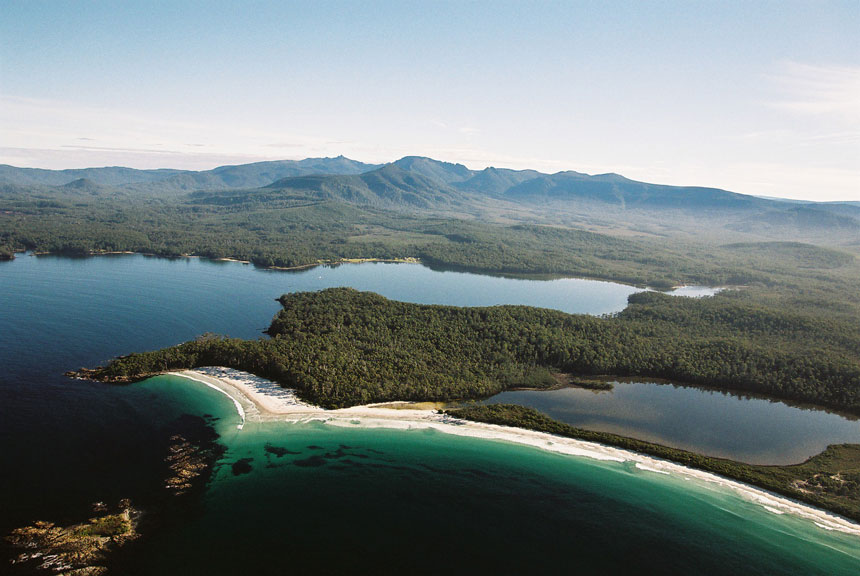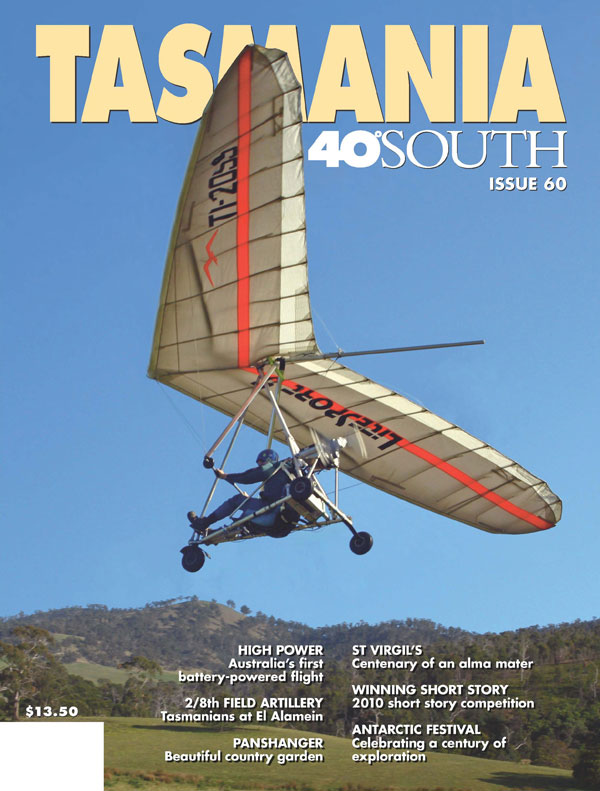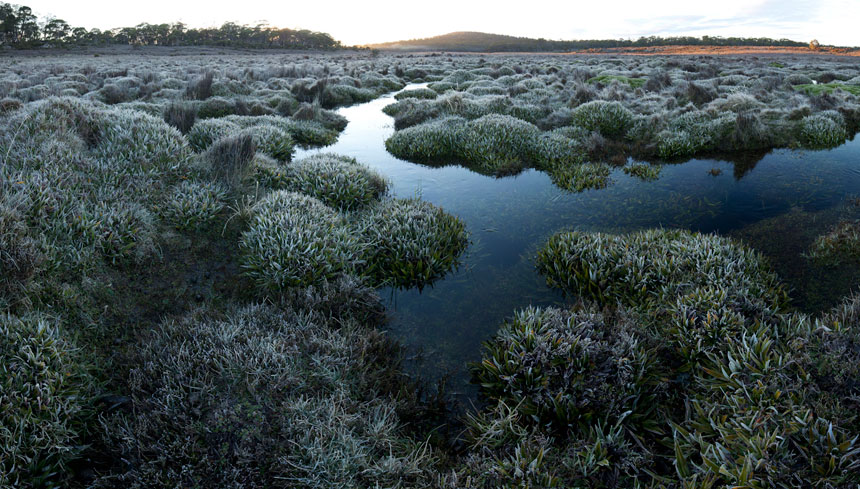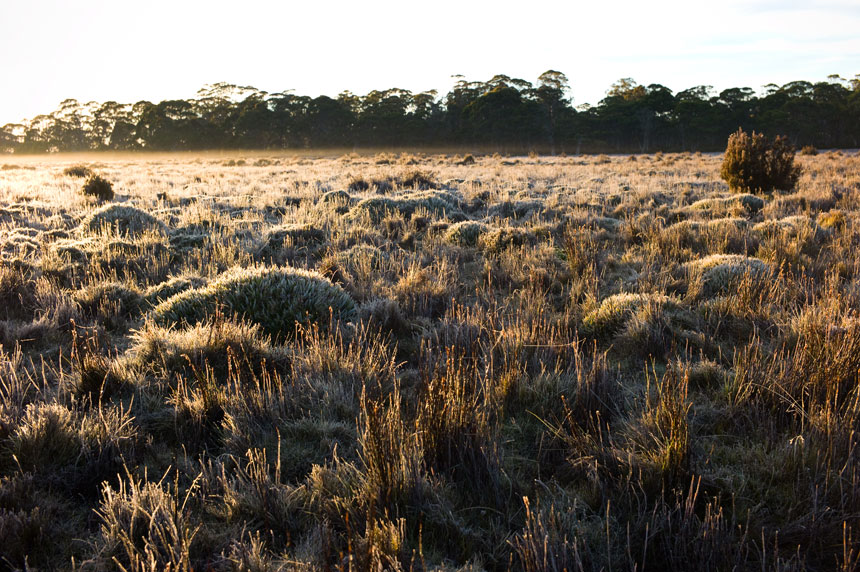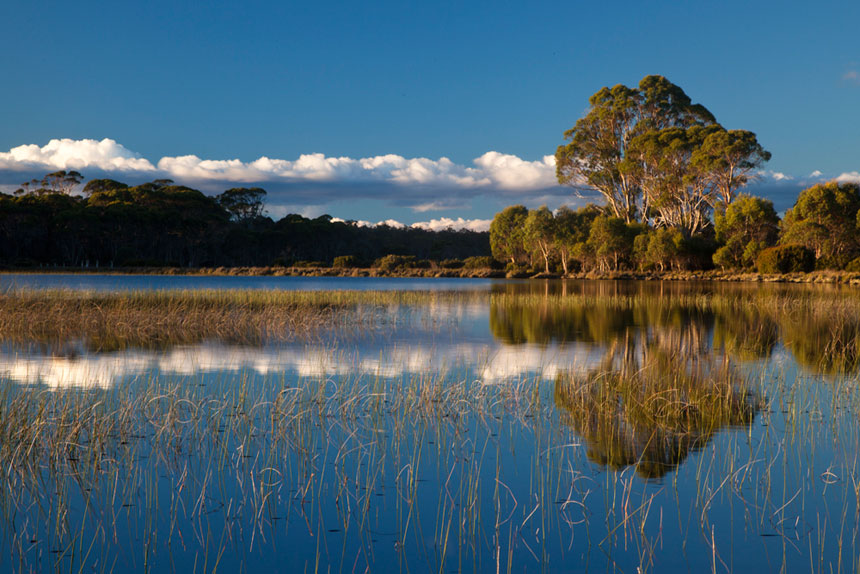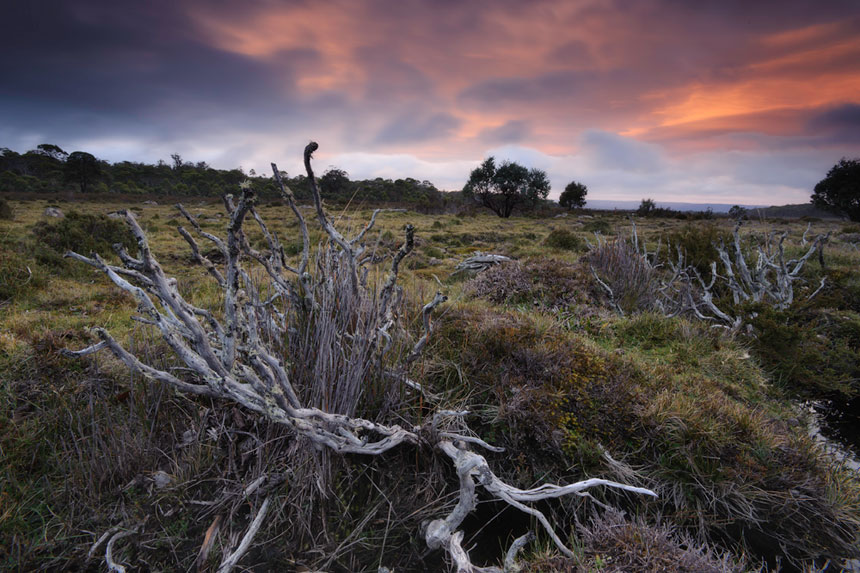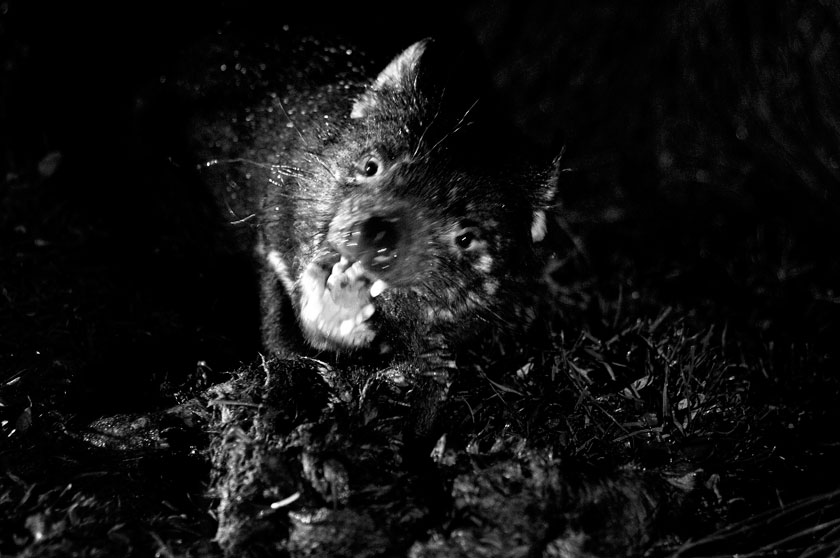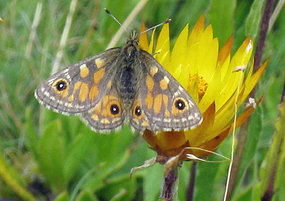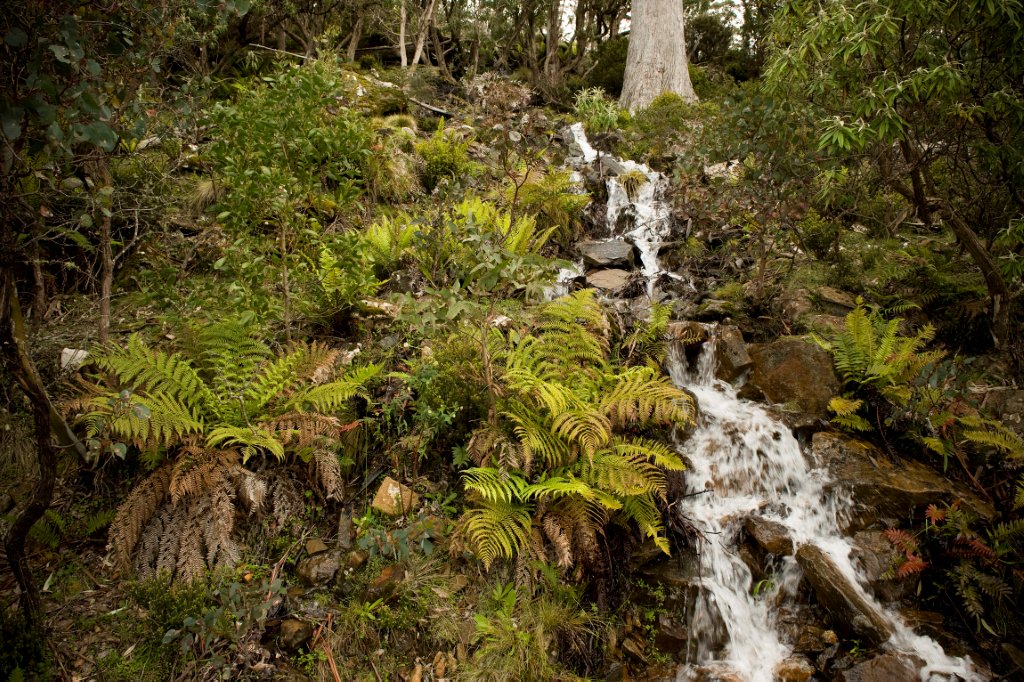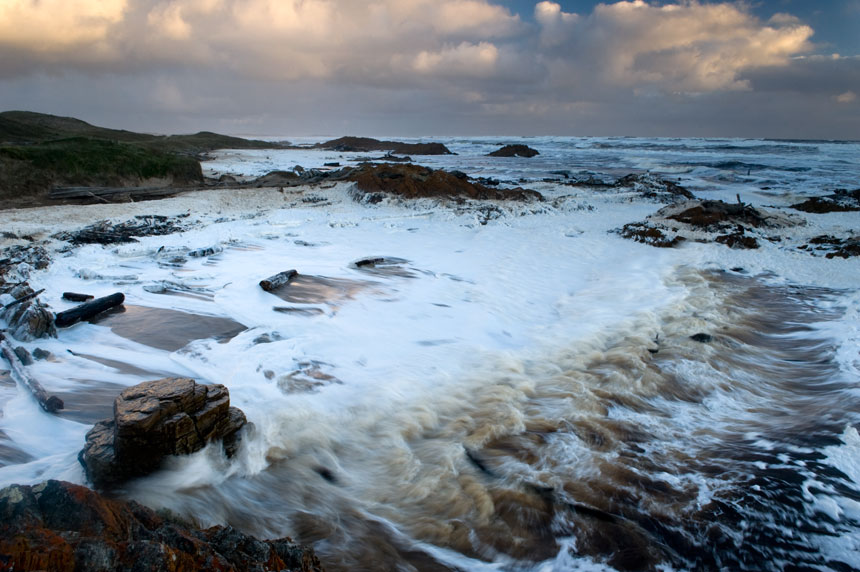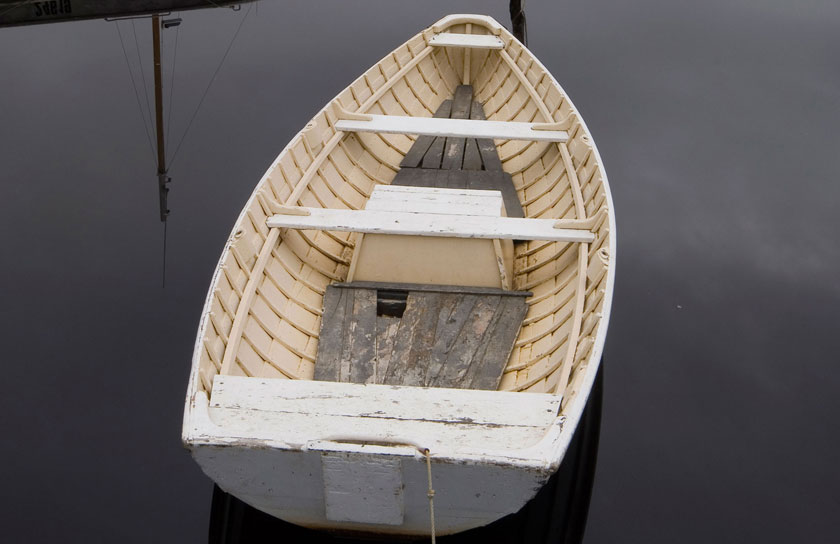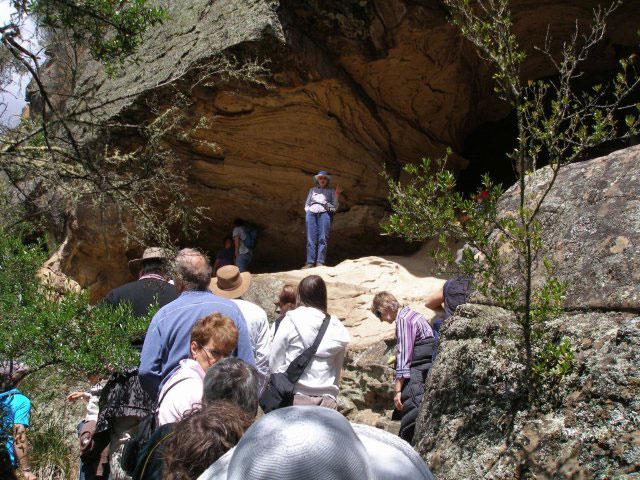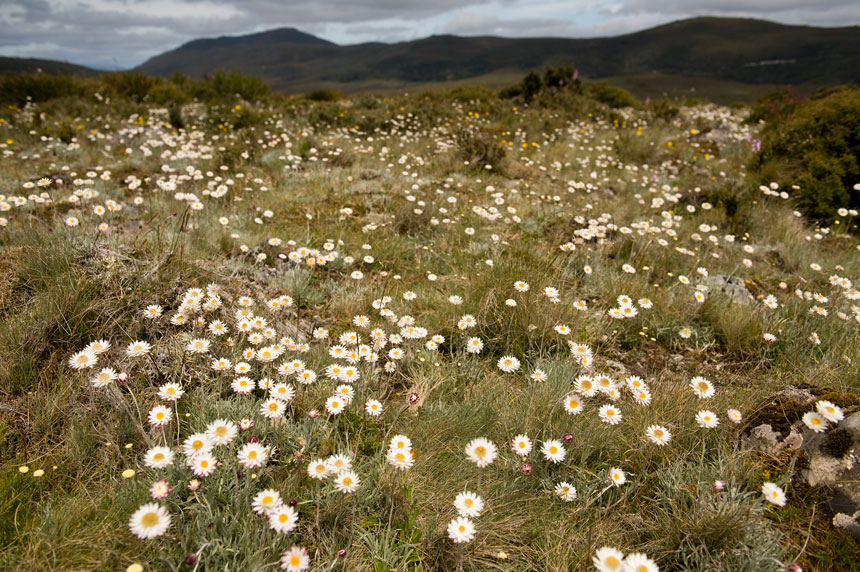Blog
Ironhouse Point Protected Area
Posted by admin on June 7, 2011
In 2011 a conservation covenant was registered on private land at Ironhouse Point, through the Protected Areas on Private Land program. The property is situated at the base of Mt Elephant and provides protection for two species of threatened fern that have an extremely restricted distribution in Tasmania.
The coastal foothills of Mt Elephant in northeast Tasmania provide a significant refuge location for conservation of threatened ferns. In late summer, the steep coastal terrain is sometimes subject to short periods of extremely heavy rainfall that results in frequent and intense flash flooding of coastal streams (Garrett 1993). This has excised deep gullies where damp and shaded conditions exist in an otherwise dry, fire-prone landscape and provide a haven for rare and unusual species, as in the image below - riparian forest, Old Billy Creek.
A population of prickly rasp fern (Doodia aspera) was discovered during the covenant survey by a TLC conservation officer. This is a highly significant find, as the species had not previously been recorded in Tasmania. The population is confined to the riparian forest understorey in a narrow band along Old Billy Creek that is subject to frequent disturbance from flash flooding and also less frequently by wildfire.
The Ironhouse Point protected area also supports a population of the threatened fern Blechnum cartilagineum. This species is only recorded in four geographically isolated locations in northern and eastern Tasmania.
The private landholder, Greg Unwin is a lecturer in Forest Ecosystems and in Wilderness Management at UTAS School of Geography and Environmental Studies in Launceston. His original proposal for the protected area was based on the site’s original stand of blue gum forest and its observed value for swift parrot and sea eagle habitat. “I have always considered Old Billy Creek to be a special place for native ferns as well,” Greg said. “So I was extremely gratified when Matt Taylor of TLC identified Doodia aspera on site and advised me of these two important records as a result of his covenant appraisal. This simply added the cream to the biodiversity cake which is now protected and managed by the covenant agreement.
The regeneration of this forest site since widespread defoliation by the Scamander / Four Mile Creek fires has been prolific. Both the Doodia and Blechnum ferns and many other plant species, including young blue gum seedlings, have flourished in the wake of extensive canopy and understorey disturbance as a result of the fire.”
TLC wins Tasmanian Awards for Environmental Excellence
Posted by admin on June 6, 2011
We are delighted to announce that on World Environment Day, Friday 3 June, TLC won two awards at the prestigious Tasmanian Awards for Environmental Excellence. The first award was in the category of "Environmental Stewardship" for the New Leaf Project which TLC embarked upon in partnership with leading Australian philanthropist Jan Cameron.
We then went on to win the overall prize: the Ministers Choice Award.
Thank you to all of our marvellous supporters, dedicated volunteers and partners who have made the extraordinary New Leaf Project possible.
To view the award nominations and winning projects in detail please click here
Let's celebrate! TLC's 10th Anniversary
Posted by admin on June 6, 2011
We could not have achieved the permanent conservation of over 2% of Tasmania's private land without the tremendous support of all TLC supporters, volunteers and partners - THANK YOU TO ALL.
To celebrate this significant achievement, we will have a weekend of festivities and acitivites at the Chauncy Vale Reserve , adjacent to the TLC Flat Rock Reserve, on 29 and 30 October 2011.
So, keep an eye out for more information over the coming months and pop that weekend into your diary.
Fair Trade Fair - Friends School
Posted by admin on May 30, 2011
Recherche Open Day
Posted by admin on May 23, 2011
Sunday was a fun filled, activities day at Tasmanian Land Conservancy’s Recherche Bay Reserve.
It was a fantastic event with perfect weather and over 100 people making the journey down south to visit the reserve.
Part of Australian Heritage Week 2011, with the terrific support of the Australia Government, the celebration was the first of its type on the property since it was protected in 2006.
The reserve is of national significance - the site that Blue gums were first described scientifically by the French botanist Labillardiere who was part of the 1792 D’Entrecasteaux expedition. The land also forms the natural bookend of the beach where French scientists and Tasmanian Aboriginal people had historic friendly meetings.
With the help of the fantastic team from the Living Boat Trust and supporters Adrian Dale and Allegra Biggs-Dale, with their craft Sealegs aquila, people were ferried over to the reserve in wonderful replica whale boats before being guided on walks and having time to take in the atmosphere of the area.
Engaging with the Agfest 2011 visitors
Posted by admin on May 13, 2011
In May, The Tasmanian Land Conservancy took the opportunity to engage with the community at large at Agfest 2011.
Our team of conservation staff are able to help landholders with
-
biodiversity assessments,
-
reserve management services,
-
biodiversity offset services and
-
carbon market opportunities.
If you are interested in finding out more please call us on (03) 6225 1399 or email us at [email protected]
[Caption:"Dr Sally Bryant (TLC) chats about conservation at Agfest 2011"]
Please join us at Recherche Bay on Sunday 22nd May 2011
Posted by admin on May 9, 2011
Recherche Bay Open Day & Heritage Celebration
As part of Australian Heritage Week 2011 celebrations, the TLC is delighted to have the support of the Australian Government to host the public for an Open Day at our remarkable Recherche Bay Reserve. We hope you and your family and friends will join us.
What: Recherche Bay Open Day Heritage Celebration
When: Sunday 22 May 2011 from 11am – 3pm. BYO picnic
Where: Moss Glen opposite Recherche Bay in Tasmania’s Far South.
As part of Australian Heritage Week, the Tasmanian Land Conservancy will open the stunning Recherche Bay Reserve in Tasmania’s far south to the public on 22 May 2011. This is the first Public Open Day on the property since it was protected in 2006. The site is on the National Heritage List.
The land is of national significance, it is the site that Blue gums were first described scientifically by the French botanist Labillardiere who was part of the 1792 D’Entrecasteaux expedition. The land also forms the natural bookend of the beach where French scientists and Tasmanian Aboriginal people had historic friendly meetings.
No RSVP required.
For more information on the TLC and our work, please visit our website or call us on 03 6225 1399
New Leaf project featured in 40 Degrees South Magazine
Posted by admin on May 2, 2011
Tasmanian Land Conservancy website
Tasmania 40°South is a magazine that celebrates all that is good about Australia’s island state.
In the latest issue there is an article about the TLC's New Leaf Project. Tasmania 40 Degrees South and its editor Warren Boyles has long been a supporter of the TLC. We would like to take this opportunity to thank Warren and his team and encourage everyone out there to get themselves a copy of the magazine.
You can read the article Here
TLC TV - Wallaby
Posted by admin on April 12, 2011
http://www.youtube.com/watch?v=xmB9qmBZlXg
This macropod is a Bennetts wallaby (Macropus rufogriseus). TLC TV captured video of this one ambulating along a vehicle track at Skullbone Plains.
Male Bennetts wallabies can weigh more than 20 kg and stand up to 1.5 m tall. Their black nose and paws, and white stripe on the upper lip are all distinguishing features from their smaller wallaby cousins – the pademelon.
Bennetts wallabies are abundant in Tasmania and TLC’s most recent reserve: Skullbone Plains in the central highlands is no exception. Unlike their mainland counterparts, Bennetts wallabies have defined breeding seasons and the females give birth in late summer to early autumn.
If you visit Skullbone Plains you will surely see them.
TLC TV - Feral Cat
Posted by admin on April 12, 2011
http://www.youtube.com/watch?v=Qot1iif0_2k
Feral cats are widespread throughout the state with sightings occurring in such remote areas as southwest Tasmania and the central highlands.
This video was shot at Skullbone Plains in the central highlands a short distance from the World Heritage Area boundry.
Feral cats prefer live prey but do occasionally scavenge carrion or human food scraps. They are opportunistic predators meaning that their diet generally reflects the fauna present in the area where they live and hunt.
Rabbits are usually the staple prey in Tasmania while other food items include small mammals, birds, reptiles (particularly skinks), frogs, fish, invertebrates and even vegetable matter. Where rabbits are absent or in low numbers -- for example in western Tasmania -- the diet mainly consists of small native mammals and native birds. Unfortunately native birds well outnumber introduced birds in the diet of feral cats in most areas of the state.
The TLC will be using its new remote cameras to help with management strategies on many of our reserves.
New Images from Skullbone Plains
Posted by admin on April 12, 2011
Tasmanian Land Conservancy website
We are really excited to show you some of the new images from Skullbone Plains.
The following images are from Andy Townsend, Rob Blakers, Hillary Younger and Matthew Newton.
You will start to see more of the new images in all the TLC publications and on the website in coming months.
Nature Photographers Tasmania visit Skullbone Plains
Posted by admin on April 11, 2011
A group from Nature Photographers Tasmania recently spent four days chasing the light at one of the TLC’s newest reserves, Skullbone Plains.
The NPT aims to use photography to help safeguard bio-diversity and the integrity of natural systems and coordinate projects and work with like-minded organisations ( like the TLC )to further conservation aims.
After a couple of days of wind and rain the light arrived on the plains, with clear sky’s and frosty mornings the photographers had everything they needed to produce some fantastic images. The TLC values enormously the pro bono contribution by NPT and we are all really excited to see the images that resulted.
We will be posting a few here as soon as they come in.
[Caption:"Photographers Andy Townsend and Rob Blakers at Kenneth Lagoon, Skullbone Plains. Photo: Matt Newton"]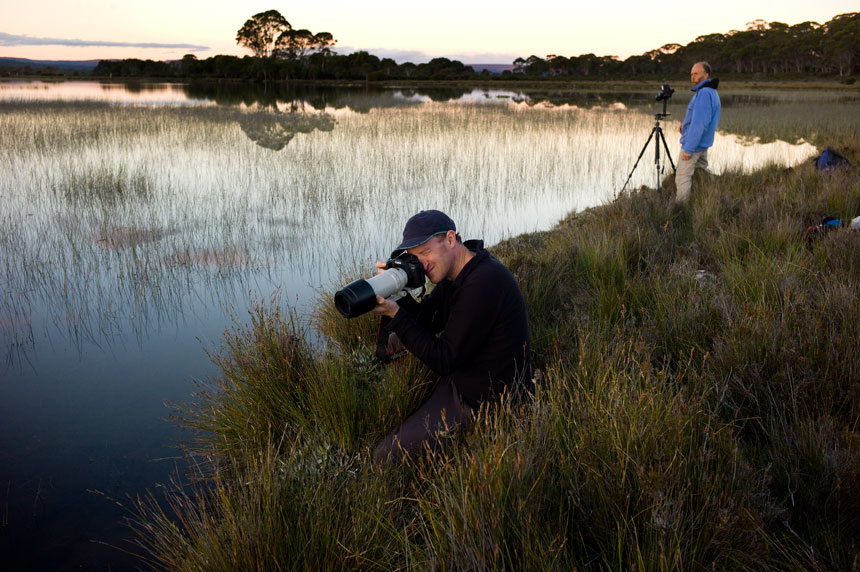
Ptunarra brown butterfly surveys at Vale of Belvoir
Posted by admin on April 11, 2011
Ptunarra brown butterfly surveys at the Vale of Belvoir are underway, with the butterflies halfway through their three week flying season. Surveys completed on Monday 21 March have supported previous findings of a large population of Oreixenica ptunarra, which are endemic to Tasmania and listed in Tasmanian legislation as vulnerable. This is the second year that surveys have been conducted at the Vale of Belvoir, with assistance from volunteers and financial support from Cradle Coast NRM. Researchers and volunteers walk slowly around permanent 10m wide transects, recording how many male and female ptunarra browns that they see, as well as other species of butterflies. This work is being undertaken as part of a greater study on ptunarra brown butterflies, including an assessment of the threats to this species, which include European wasps.
[Caption:"Ptunarra Brown Butterfly at the Vale of Belvoir. Photo: Denna Kingdom"]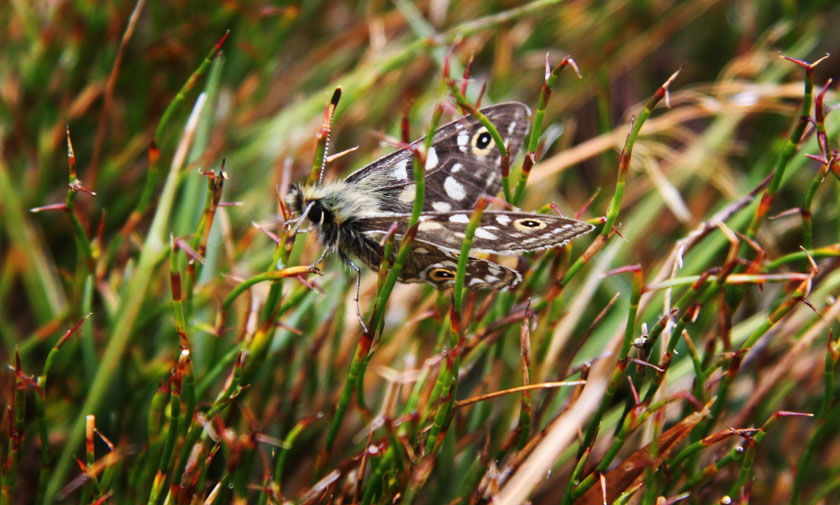
TLC TV - Tasmanian Devil (Sarcophilus harrisii)
Posted by admin on March 29, 2011
Our first attempt at filming wildlife at Skullbone Plains has been a great success !
Watch the video to see what turned up on the first night of filming.
http://www.youtube.com/watch?v=1kdugYF_Tpo
Dr Sally Bryant, Wildlife Ecologist and Reserves Manager at Tasmanian Land Conservancy, says this about the Tasmanian Devil (Sarcophilus harrisii) in her book: Animals of Tasmania - Wildlife of and Incredible Island (2009); Quintus Publishing.
Although the Tasmanian Devil is a carnivore and can easily kill prey many times its own size, its talent is more for finding than killing food. Devils can travel up to 10km a night in search of carrion and with their acute sense of smell can locate a dead body up to 2km away. With their powerful jaws and vice-like grip, they can devour any kind of carcass, eating everything, including fur, bone and guts…They are strongly built animals and adult males can weigh up to 13kg and females up to 9kg. They are black in colour, many sporting an individual white blaze across the chest and with a scrawny tail with a wispy end. While at times highly social, devils are more often solitary and territorial in nature and during the breeding season males will fight aggressively to defend their territories and to guard their female. Females give birth to many young but can only accommodate and rear four pups in a year. This reproductive trait supports survival of the fittest…Devils can live for five to six years in the wild but by then their coats have become shabby and worn and their faces are pitted and scarred from years of fighting.
Up until the 1990’s Tasmanian Devils were common and widespread, with a population estimated at about 150,000 (Nick Mooney pers. Comm.). But then everything changed. In 1996, devils were found with horrendous facial tumours, caused by a new type of infectious cancer…What triggered the cancer is unknown but the disease is now widespread and the devil population has plummeted.
The Tasmanian Devil has become a nationally endangered species and the world is learning of its plight.
You can help by donating to the Tasmanian Land Conservancy to protect 1600 hectares Devil habitat at Skullbone Plains! Please donate at http://www.tasland.org.au/donations/
Working Bee Flat Rock Reserve Sunday 20th March 10am to 3pm
Posted by admin on March 8, 2011
Flat Rock Reserve was established as a protected area by the Tasmanian Land Conservancy and Southern Midlands Council in 2006 to protect the special natural values on the land and to extend the Chauncy Vale Wildlife Sanctuary.
We encourage the local community to help us look after these reserves. In the past students from Bagdad Primary School and community volunteers have spent time planting seedlings, removing rubbish and developing some walking tracks.
For this working bee we are planning to remove weeds near the entrance of the reserve, tidy up some rubbish and plant some seedlings to encourage regeneration of the bushland in disturbed sights. All tools and equipment will be provided by TLC.
When: From 10am to 3pm Sunday 20th March
Where: Flat Rock Reserve, East Bagdad Road, Bagdad. Turnoff the Midland Highway up,”East Bagdad Road,” Bagdad. The reserve is 5 km up this Road where the road turns from bitumen to gravel. We will meet at the entrance gate, which is on the right hand side of the road.
What to bring: Lunch, sturdy shoes and warm clothes to work in. Bringing some gardening equipment from home would also be helpful, including gardening gloves, a small shovel, and secateurs or loppers. Please make sure any soil is washed off your gardening equipment before bringing it along, to stop seeds and plant diseases being brought in to the reserve.
Transport: Flat Rock Reserve is about 45 minutes drive north of Hobart. We are happy to arrange car pooling, so please indicate if you are looking for, or able to provide, a lift to the working bee.
Positions for the day are limited, Please RSVP to [email protected] or contact Tim Devereux or Denna Kingdom on Ph 6225 1399 by the 15th March.
TLC TV
Posted by admin on March 8, 2011
Last weekend we set up a remote video camera at Skullbone Plains to see what is out there. The camera is described on the US manufacturers website as “the needest liddle camera in the woods”.
Tune in to the Blog next week to see which of the fantastic animals from Skullbone Plains features on TLC TV !
[Caption:"TLC Staff member Jane Hutchinson setting up the "needest little camera in the woods""]